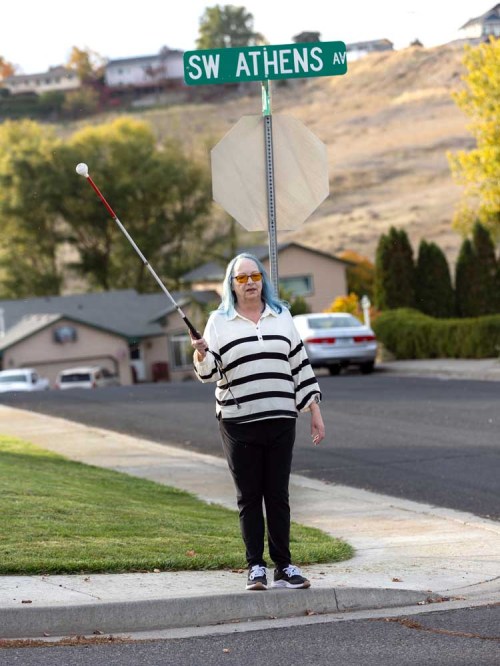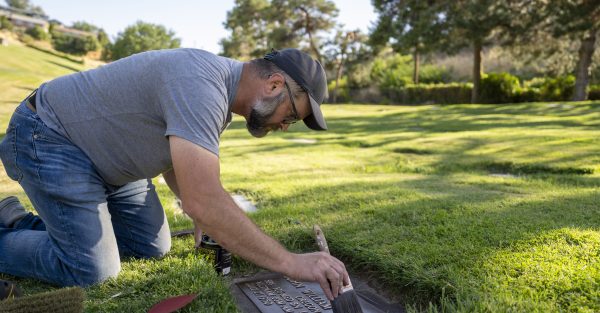White cane, technology bring independence
Published 6:00 am Tuesday, October 31, 2023

- Merielle Bernier waves her white cane in an arc over her head to signal she is about to cross the street during a recent walk near her southwest Pendleton home.
PENDLETON — When Merielle Bernier lost her vision, she became a problem solver.
The Pendleton woman uses technology and her other senses to replace her eyes. When dressing, she scans her clothing with a device that tells her, “blue,””beige,” “multicolored plaid” or other descriptor. Her meat thermometer speaks too.
Trending
She pours coffee with the help of a device that tells her when her cup is full. While grocery shopping, she scans the shelves with a gadget that reads barcodes. She relies on a program that guides her through knitting and crochet patterns and tracks the number of stitches.
Bernier, a diabetic, checks her glucose level by saying, “Hey, Siri, what’s my glucose?” An implanted sensor gives Siri the answer and, if the glucose level is off, Bernier gives Siri a code and the proper amount of insulin is administered.
Bernier often converses with an Echo and relies on a barrage of iPhone reminders.
The law on the caneShe has retinitis pigmentosa, a disease in which the cells of the retina break down and peripheral vision slowly recedes. She has been legally blind (less than 20/200) since 2017. Bernier is completely blind in her right eye. In her left, her vision is similar to looking through a straw. Bright sunlight completely blinds her.
Bernier blames genetics and a two traumatic brain injuries suffered during her 23-year military career as a Navy linguistic specialist for the other complex eye disease that couples with her retinitis pigmentosa. She won’t give specifics except to say, “I speak a lot of languages so I did some interesting things in the military.” She speaks fluent Hebrew, Farsi and Pashto.
Going outside presents challenges that technology can’t completely mitigate. When Bernier leaves the safety of home or vehicle, she knows a white cane is no guarantee of safety. GPS directions flow from an AirPod in one ear while she listens for ambient noise with the other. In her right hand, she clutches a white cane.
Trending
She has a collection of canes or “sticks” for different types of terrain. She uses a long cane with interchangeable tips to tap or roll from side to side. Other canes are shorter or thicker, each with a specific purpose. She also has an array of tips with names such as pencil, bulldog, marshmallow, ceramic, roller ball and Dakota. The latter is a dinner plate-sized tip used for hiking.
Oregon law says motorists must give right of way to a pedestrian carrying a white cane (or using a guide dog) when they cross a roadway, even if the driver has a green light.
October is Blind Awareness Month, which includes White Cane Awareness Day, but Bernier said people sometimes seem unaware of white cane etiquette.
“People have almost run me down,” she said. “They have turned in front of me and yelled at me.”
A person must be legally blind to use a white cane. Oregon law says it is “unlawful for any person, unless totally or partially blind or otherwise incapacitated, while on any public street or highway, to carry in a raised or extended position a cane or walking stick which is white in color or white tipped with red.”
At crosswalks, Bernier typically raises her cane high over her head and waves it in an arc to signal she is about to cross. Sometimes motorists don’t stop so she relies on her hearing to detect approaching cars.
‘Be patient’
Carol and Mary Ann Hernandez, two Pendleton sisters who are legally blind, haven’t fully given in to the idea of carrying white canes. They and about 20 other members of their family started experiencing symptoms of retinitis pigmentosa as children and slowly lost their vision.
Mary Ann carries a thin white cane called an identity cane, which identifies her as someone who is legally blind. Since starting, she has noticed more drivers slow down when she nears a crosswalk.
“Seems like when they see the cane, they will slow down,” she said.
Walking city sidewalks with a visual impairment is sometimes a gauntlet. Cracks and grooves can cause trips and falls.
“I am super afraid of getting hurt,” Mary Ann said.
Her younger sister, Carol, 47, balks at the idea of using a white cane, but admitted she plans to get one soon, simply so people will understand when she doesn’t behave like a sighted person.
“I’ve been yelled at in stores for being slow,” she said. “People don’t recognize that I don’t see.”
She urged patience.
“Be patient. Have understanding,” Carol said. “It’s really hard.”
Help but don’t touchAlso, she said, recognize that blindness isn’t all or none.
“There’s a huge misconception about being blind,” she said. “They assume you can see or not see. That’s not the case.”
She described entering the Great Pacific in downtown Pendleton recently and having to stop abruptly because her limited vision went dark. Her eyes gradually adjusted as other customers eddied around her.
“It took a whole two minutes for my eyes to adjust,” she said. “Sighted people’s eyes adjust within seconds.”
Bernier said people often try to help. She appreciates it when sighted pedestrians warn her of obstacles ahead, but not when they try to physically move her to a better spot.
“Don’t ever touch someone with a white cane,” she said. “It can throw them off balance and cause a fall.”
She is frustrated when people assume she isn’t intelligent because she has a disability.
“Just because we have low vision,” she said, “doesn’t mean we aren’t competent or capable.”









